The 'wonder' of going back to basics and handmade....
by Ruvini De Alwis
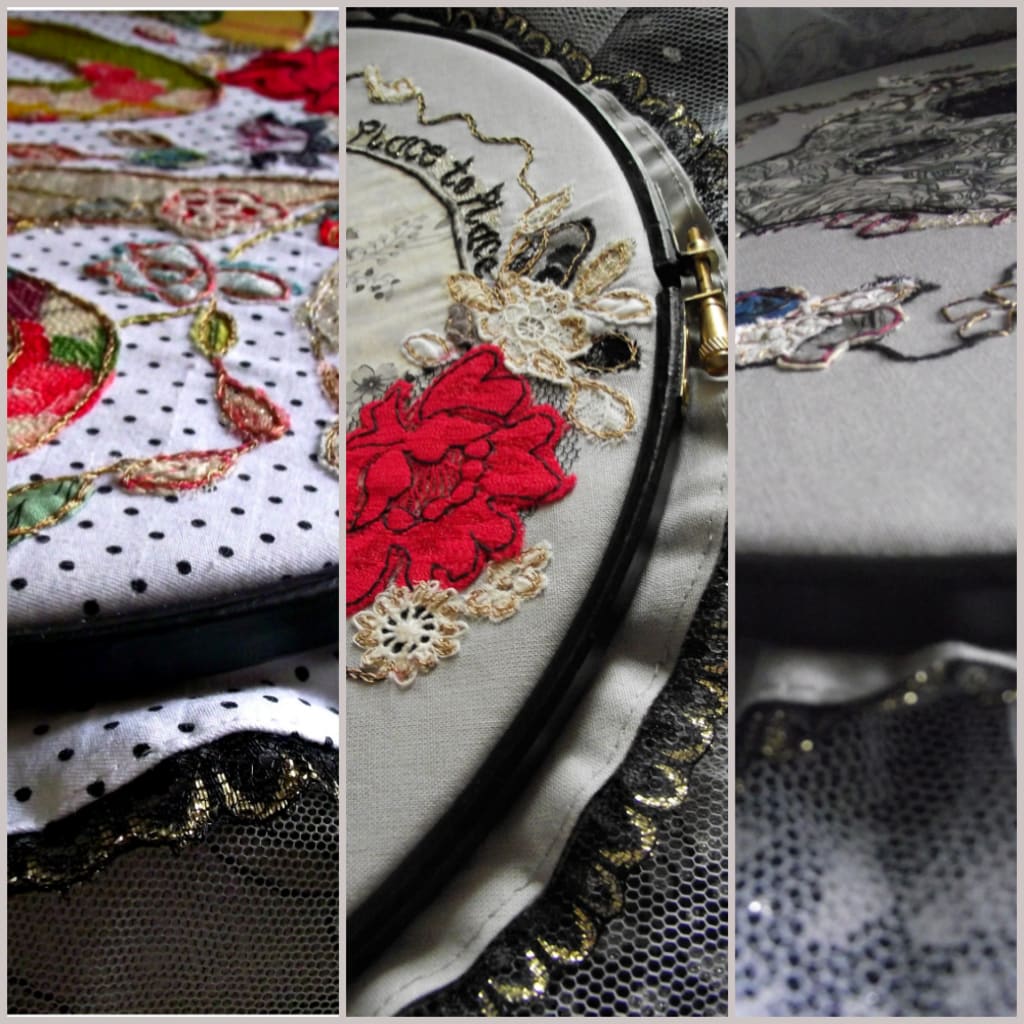
I describe it as working to the bone, hand sewing often comes with scratches and pin pricks but the effort is worth it. Two things of anything you make that’s handmade are never the same. There’s always something that slightly different about it. I make collections of brooches, stylised embroidery hoops and sewn pictures as part of my work but I do other things as well. All my crafts require cutting, stitching, and a lot more time than sewing on a machine.
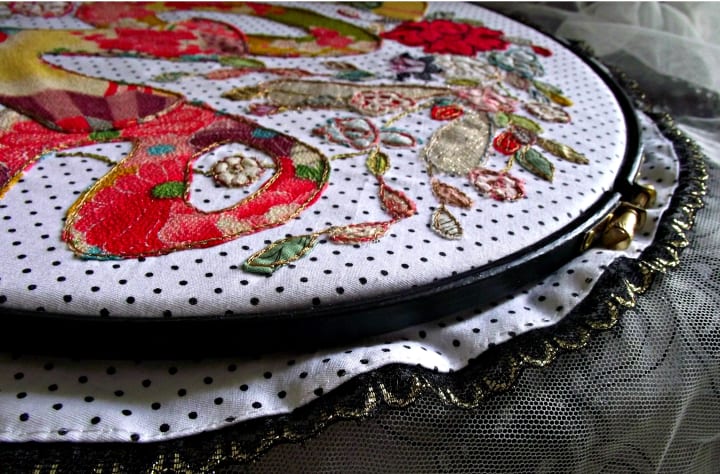
Usually with an apron, pins tucked into my sleeve and of course, a pair of scissors. I used to go through quite a lot of scissors until I settled on a pair of Fiskars which are long lasting and always reminds me weirdly of Scandinavian salmon....that’s unlikely but there you go, strange what associations spring to mind. I always imagine Sock eye = Canadian salmon and Fiskars = Scandinavian salmon although Salmon have no nation states just rivers...but back from that slight diversion or maybe tributary where salmon are trying to swim upwards, they really cut better than all my other scissors which adds efficiency to my work and gives a clean finished look Having the right scissors makes a difference. This all started with having bouts of being technologically defunct, which I have experienced a lot in my life. I can go for whole periods where I cannot go on a laptop, it’s stressful and I have ‘fallout’ from it. I can do digital, I said defunct not incapable but can't deny I often struggle. That’s how the hand sewing started. An innate desire and a frustration to get my creativity out but be realistic...and then the ideas started to flow.
I’ve been into art for a long time and making and creating things comes naturally but at some point you begin to realise that you can actually make money from all these skills so that’s exactly what I started doing but really because I wanted to live a low impact life and one that was less intensive and more sustainable. What does this mean exactly, well when broken down it just gives more time for other things. If you are someone that is curious about the world then time is precious and a lot of art actually arises from sitting and doing nothing....it’s a process that requires time, if you are working for yourself. I did not plan on how it would look exactly but found that a lot of things I made were actually kitsch without trying, so I went with that and started creating small accessories with a style. My brooches represent a fascination with colour and particularly the kitsch type of colours found in Indian, Mexican influences, culturally and artistically.
I suppose this has a lot to do with being born somewhere tropical, where the colours are vibrant enough to stick in your mind forever. My memories contain colour, the type that’s sort of ecstatic (not exotic) because the colours of saris and jewellery are such an abundant mix of life. What sticks to mind are those tropical blooms that grow everywhere, gardens, waysides, green patches, forests, sea sides. We used to have a courtyard where we’d bathe outside and I always remember a tiger orchid tree that just kept growing bigger and bigger with every year. This tree was surrounded by smaller blossoms, hibiscus, jasmine, frangipani, anthuriums. I would bathe there surrounded by all these blooms. Tiger orchids always make me think about bathing but outside. I have bathed in many rivers since. My favourite places are the icy cold rivers and springs in South/North Dakota, Montana because the water is so cold, clear and are filled with forget-me-knots. I love its stark simplicity and fierceness because a little further on could be rapids. A sea of blue is what greets you and I can think of no better way to take a dip.
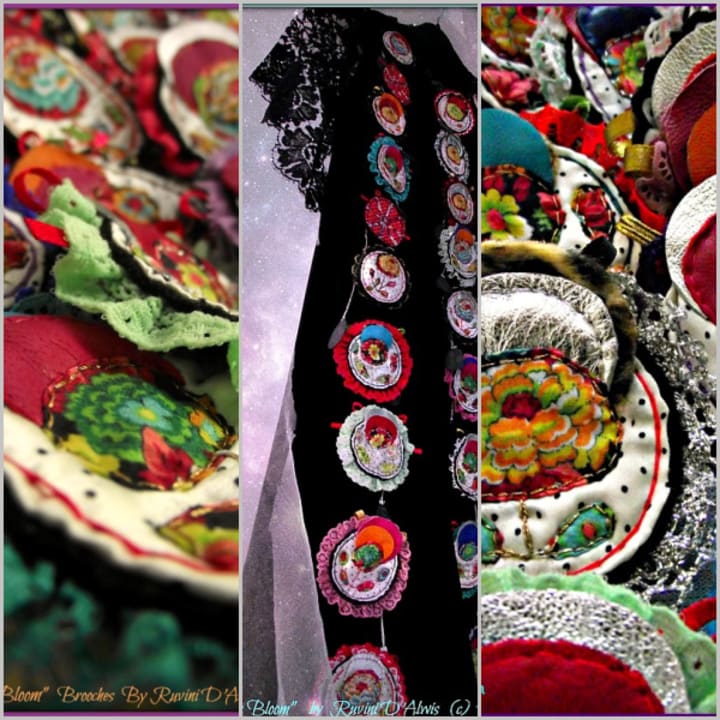
Since I have grown up in the UK, there are a lot of those influences too, I am also a Honiton lace maker, a type of lacemaking that has its roots in the Devon/Somerset region. This is a dying art in the UK with about 13 really good teachers left that teach this type of lace making. The work is beautiful and it takes so many hours to create one piece that you feel a little humbled by the hard work. You imagine women at work for hours creating these intricate works and that is exactly how it was. My work is contemporary but I am also a bit of a traditionalist being culturally interested in peoples’ arts and lives. I have learnt more from my lace teachers, about so many things aside from lace, about the war, the things that happened to them and what they went through, about bee keeping, about travel, about relationships.... They are all grandmothers and very knowledgeable about life. I am the only ‘younger’ person (although not young) and an outsider and often I love being in their company and feel I have a lot to learn. We use many different scissors for lace, usually small, intricate, pretty and in the shape of animals and flowers. Sometimes its like meditation, when the cruelty of the world makes deep cuts I often like to sit and make lace, it's very grounding...
The lace industry was not glamorous, only for those who could afford the final result. It involved young children, long hours, it was physically exhausting, bad for your back, hands and posture, often involving poor working conditions, although men faired better, in better positions and jobs. Some pieces could take years to complete. It’s easy to drool over these works of fine art but it was labour intensive work for which there was little pay or benefits, especially for women and is linked explicitly to the cotton industry from which fine threads were woven and to the history of slavery. Machines ended up replacing the handmade lace industry in the 1800’s. The quality of lace will never be the same again but at the time it was thought to be of a better quality than handmade. Sometimes the most beautiful things live alongside the most ugly, painful experiences and makes me look at some fine art differently, because of the history, human cost and pain which is sometimes startling and impossible to ignore. Lace was originally brought to the region by Flemish refugees. Different types of lace are made all over the world, having distinct styles, methods and ‘stitches’ or ways of working.
I often think about when I get really old and maybe have arthritis, but none of the grandmothers I make lace with do and one is over 90 years old, fit and full of life. I am often told that's it's a state of mind and think a lot about mental agility. Their lacework is some of the best I have seen. Bobbin lace in very finger intensive, it’s like a workout and requires a lot of patience and concentration. If you feel slightly agitated or have a lot on your mind, it’s best to leave it alone...it’s something best done with time and little distraction.
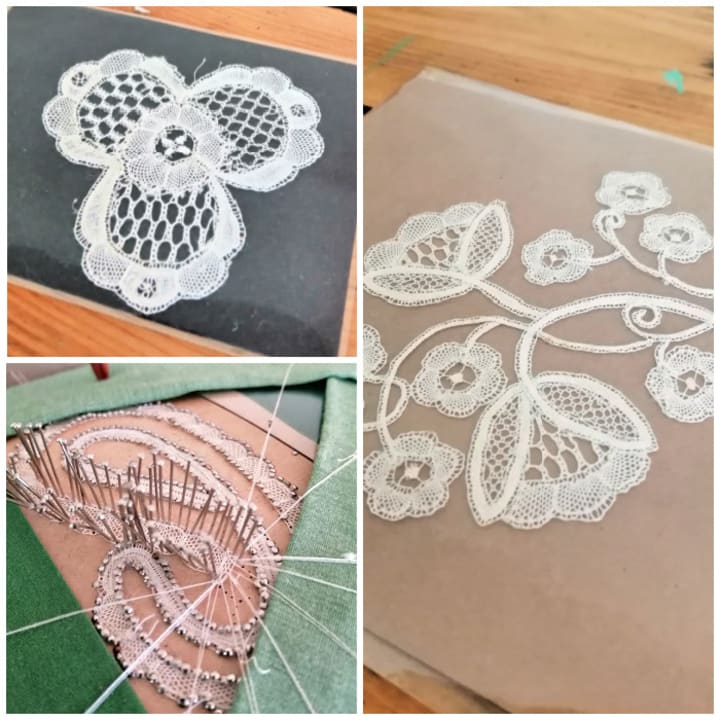
I used my art to travel also because I love to see, touch and feel what’s happening out there and would sometimes just drive finding really bespoke boutiques in new towns, while travelling in a van, walking, hiking, examining plants and habitats as I am also an ecologist and learning as much as I can about the environment. The thing about the environment is you learn to understand it more and more when spending time there. Some of the best animal experiences I’ve had have been when travelling alone. It’s almost like they (animals) know and are not afraid to show themselves. It was work of a kind but inspirational and always with a burning need to get back on the road, which all though I am much older now, I still have.
I made contacts this way and would talk to boutique owners who never turned down an opportunity to see what new artists were making, even if it was not quite right for their store. It was interesting also to see how unique their small boutiques and businesses were and I loved that. When travelling I would always have a suit and a lovely bag and I would go into a boutique, talk to owners, find out what they wanted took notes for future reference and sometimes just sell 'over the counter', it was an experience that I combined with travel. Many small, bespoke boutiques often don’t have a website and it’s an interesting way of working and finding out about new places, towns, history, geography, culture and also the environment, although I doubt many people would want to work this way because it’s (physically) hard work and you are constantly multitasking but it's research.
I always thought that one day I would have my own unique boutique, somewhere obscure, hidden away like a treasure trove that you would have to seek out but things didn’t work out that way. I wish my life could be more stable but it never is, not for long and it’s usually beyond my control and I have just ended up moving on.
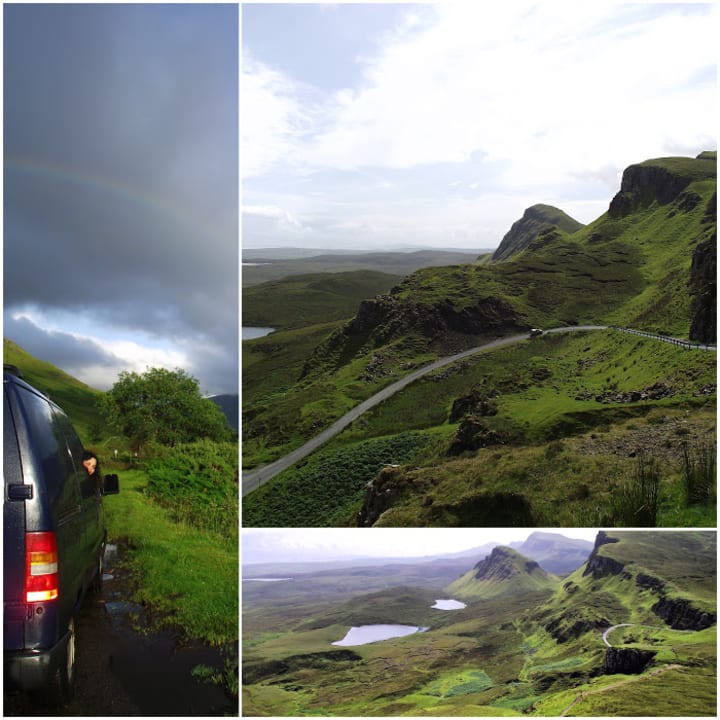
There’s always ribbon and fabric lying about somewhere, bits of felt, threads. When I had my workshop in a barn, out in the middle of rural 'nowhere', the boisterous feral farm cats would come and push their way around, sometimes things would fall off the table, light would hit the ground, on threads with glitter and they would shine. The play of light was always fascinating, the surroundings were industrial, rural, green and rustic and could be quite wild. 'Wild' is an overused word to describe many environments but here it was really wild for farm areas. It would be cold as there was only an oil heater, no wood burner or any other heating. You’d go through winters when the power would just go in the middle of something as there’s always storms around with lightning, that was quite elemental. Power lines were easily taken out but I got used to it, the cold, the cats, the power going out, water freezing over, barn owls that would perch outside at night and bats in the roof. They were tiny, dark brown, pipistrelle. They’d peek their heads in to see what I was doing sometimes and would make a racket at night when I was working late. I used to worry that they’d start coming out and flying around, it was more a curiosity as if they were ‘checking me out’ to see who they were sharing their space with. After all they’d been there a lot longer than I had but they never did beyond a peek here and there.
Bats are protected in the UK under the Wildlife and Countryside Act because their numbers declined so rapidly. They are also a biodiversity indicator species, meaning that they are a good indication of the general health of an environment because of things like insects that they feed on and other plants and animals linked to this. It is a criminal offence to harm one or disturb their roost. The thing is they could have frightened the life out me, one cold, quiet night when working all alone, no one around, pitch black, no lights outside, just a sky full of bright stars.... I started to like them then and decided I didn’t mind if they came out to say "Hello" once in a while...just not on my fabrics, please!
It was hard enough to stay clean, this was not a pristine environment. I had wolf spider nests in cracks in the stone wall, hornets that try and make a nest if you even leave the window open for just 2 minutes, spiders, woodlouse, all manner of creepy crawlies, feral cats and birds that also have nests in the roof and sometimes fly inside.... also just for a peek. Sometimes Robins were so aggressive that they’d peck hard on the window until they got my attention, as if saying “can’t you just leave it open”. Leave the window open wide enough, you half expect a hawk to fly through it. I have enough things on my hands to worry about apart from being this alert all the time...but I got used to the smell of stone, wood and cattle from the field next door and learned to except animals into my world because really I was in their world, was it a question of accepting or being accepted? At least we are not in the mountains in the USA, living in the middle of nowhere. I have seen what bears can do when they want to get at the chickens, not to mention the mosquitoes, rampant in summer. That is another level of alertness which can be more intense. It was at the very best, kind of comforting and the very worst slightly stressful but the wildflowers were glorious in spring, enough to make up for the calamitous stress. Just be grateful for small things...
Looking at the granite stone that this workshop is built out of, I think how well made it is. There’s never any damp, leaks or anything belying it’s ‘rusticness’. There is something really rewarding about using your hands and making something that well, at least what you consider to be likeable, sellable or someone who likes your work. It’s the explorative process that makes it all worthwhile and the final outcome; really making people happy, even if it’s just that one moment of joy...a smile or making people think, wonder, how did she do that or even think of doing that or what does it mean?
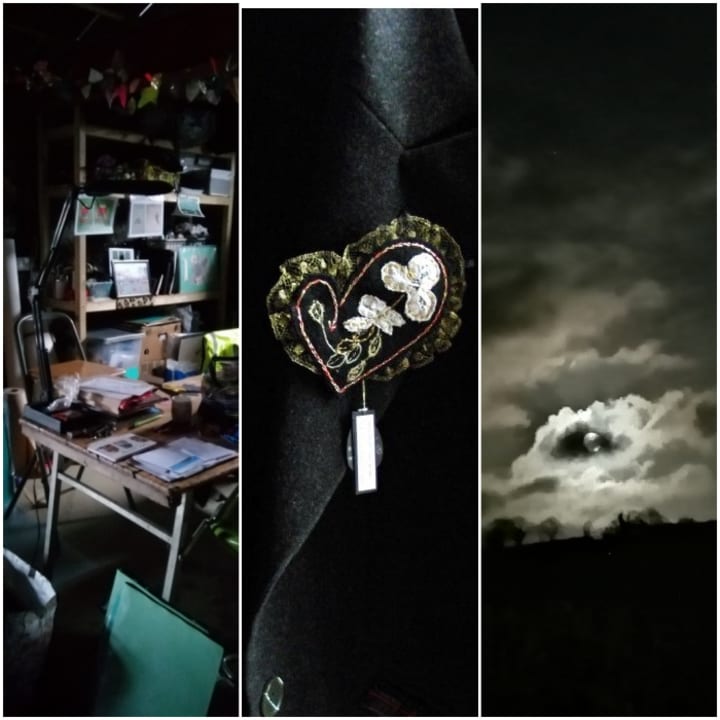
Things have moved on now and I have done more with my art and taken it further, something that has happened naturally, from just doing what I love and feel committed to while working hard....it is now encompassing other areas of interest while finding ways to bring all elements of my work together. That’s the best kind of happiness you can get from your work, it's an intimate process and long lived....you just keep going, living and putting your heart and soul into it! It's such a part of my ordinary life that I often don't notice the hours pass by...all things aside (even scissors) I am glad I went back to basics.
By Ruvini De Alwis
If you want to see more of what I am doing, visit me @ www.bloomlore.com
About the Creator
Ruvini De Alwis
Artist/Ecologist/writer @ www.bloomlore.com
Enjoyed the story? Support the Creator.
Subscribe for free to receive all their stories in your feed. You could also pledge your support or give them a one-off tip, letting them know you appreciate their work.

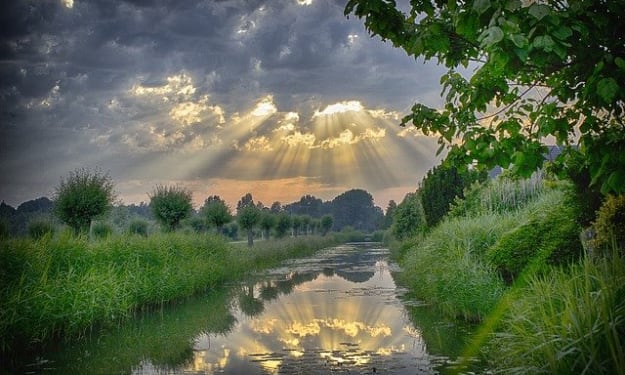



Comments
There are no comments for this story
Be the first to respond and start the conversation.